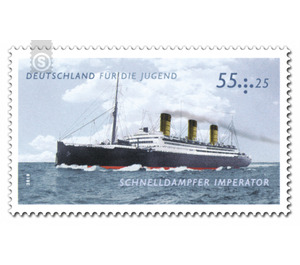Youth: Historic express steamers - Germany / Federal Republic of Germany 2010 - 55 Euro Cent
Theme: Post & Philately
| Country | Germany / Federal Republic of Germany |
| Issue Date | 2010 |
| Face Value | 55.00 |
| Printing Type | Multicolor offset printing |
| Stamp Type | Postage stamp |
| Item Type | Stamp |
| Chronological Issue Number | 2683 |
| Chronological Chapter | GER-BRD |
| SID | 53879 |
| In 21 Wishlists | |
The proceeds from the additional stamps "For the Youth" have been donated to the "Stiftung Deutsche Jugendmarke" for more than 40 years. With these funds in the area of child and youth welfare, it supports, for example, supra-regional youth education centers and meeting places as well as measures of special and exemplary significance, which serve the further development of youth welfare. This year, the youth brands show historic steamboats. The introduction of the steam engine in conjunction with the paddle wheel and later with the use of the propeller meant a technical revolution in modern shipping history. The use of the steam engine has been enforced since the early 19th century as a propulsion on inland waterway vessels and later seagoing vessels in North America and Europe. But only the achievement of a high vapor pressure with a corresponding efficiency by efficient boilers formed the condition for the advancement in the steam technology. From the simple cylinder boiler developed the water tube boiler. By perfecting the piston steam engines with a fourfold. Expansion and with several cylinders, the limits of the classic marine steam engines were exhausted with about 45,000 hp. Larger machine performance for the fast passenger ships in the North Atlantic traffic made possible only steam turbines. The piston steam engines proved successful because they were reliable and economical in operation. Steamboats were built in Germany until the 1960s. But even before the First World War diesel engines were used in sea shipbuilding, which displaced the steam engines. Today they are the usual mode of propulsion in modern ships. The steamer IMPERATOR was with 52.117 GRT and a length of 277.06 meters until 1914 as the largest ship in the world. With the steam turbine plant and the 46 water tube boilers, the ship reached a speed of 23 knots (about 42.6 km / h) with its 61,000 hp. The IMPERATOR drove after the First World War under the British flag as BERENGARIA until 1938 between Southampton and New York.


